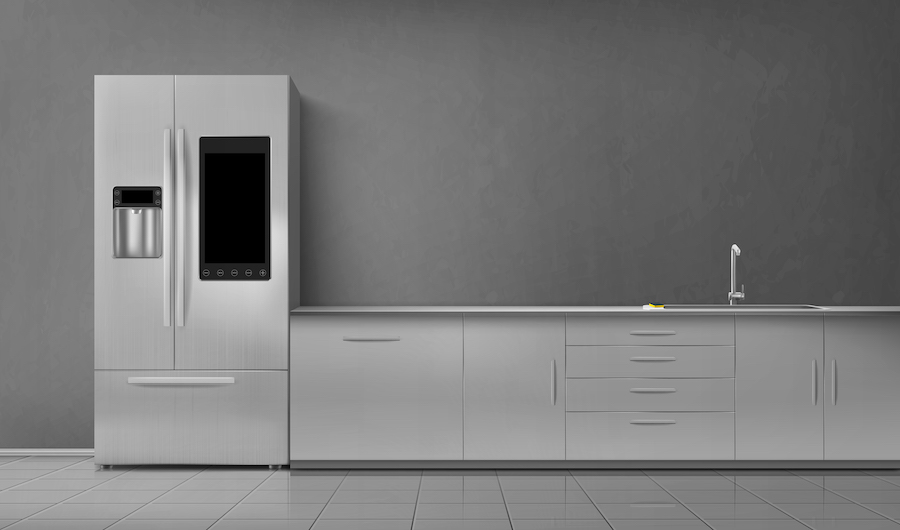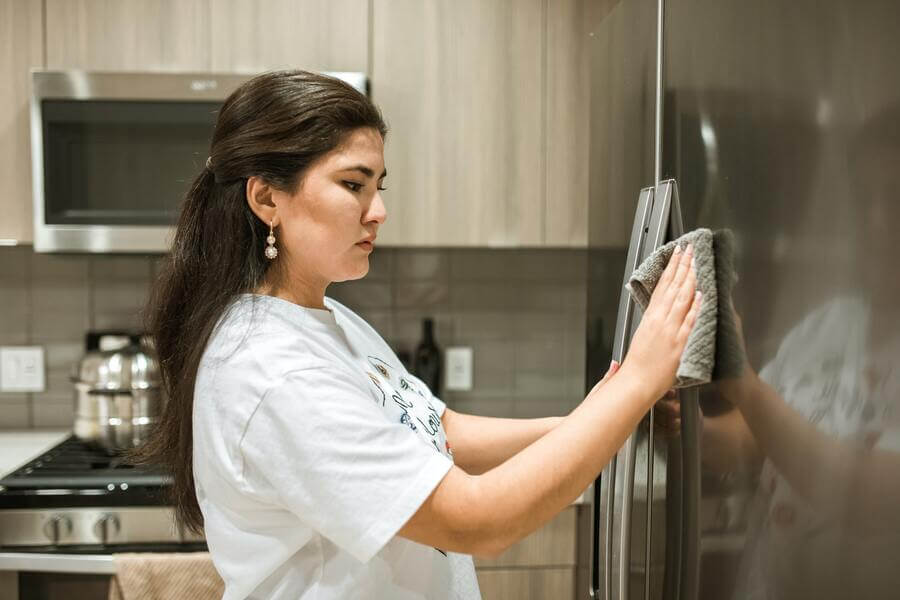Your GE Profile refrigerator is a vital appliance in your kitchen, keeping your food fresh and your drinks cold.

But what do you do when you discover water pooling under the deli drawer? This unexpected issue can be frustrating and concerning but don’t worry.
In this guide, we’ll walk you through the common reasons behind this problem and provide simple, step-by-step solutions to help you fix it and keep your refrigerator in shape.
GE Profile Refrigerator Leaking Water Under Deli Drawer: Understanding the Issue
Before jumping into the solutions, let’s understand why your GE Profile refrigerator might leak water under the deli drawer. This problem is usually caused by one of the following issues:
1. Clogged or Frozen Drain Tube
Your fridge has a drain tube responsible for whisking away excess water from the defrost cycle to a pan beneath the appliance, where it evaporates. But if this drain tube gets clogged or frozen, the water can’t escape, leading to a leak.
Solution: Unclog or Thaw the Drain Tube
A clogged or frozen drain tube is a common culprit for water leakage. Here’s how to fix it:
- Please turn off the Refrigerator: Unplug your refrigerator from the power source or switch it off at the circuit breaker to ensure safety.
- Locate the Drain Tube: The drain tube is usually located near the bottom at the back of the refrigerator. It may be covered by a panel that you can remove for easier access.
- Unclog the Drain Tube: Carefully inspect the drain tube for any obstructions, such as ice or debris. A turkey baster or a thin, flexible wire clears the clog. Be patient, as this might take some time.
- Check the Drain Pan: You’ll find a drain pan beneath the refrigerator. Ensure it’s clean and properly positioned. If it’s damaged, consider replacing it.
- Test the Drain: Pour a small amount of water into the drain tube to ensure it flows freely into the drain pan. If it does, you’ve successfully resolved the issue.
- Power On: Plug in your refrigerator or switch it on at the circuit breaker. Monitor it for any further leaks.
2. Blocked Evaporator Coils
Dust and debris can accumulate on the evaporator coils in the freezer. When these coils get blocked, it can cause excessive condensation, eventually dripping into the refrigerator section.
Solution: Clean the Evaporator Coils
Blocked evaporator coils can lead to excess condensation, causing water to drip into the refrigerator. Here’s how to clean them:
- Turn Off the Refrigerator: Unplug your refrigerator or switch it off at the circuit breaker.
- Access the Freezer: Remove any items from your freezer and remove the shelves and drawers to access the back panel.
- Locate the Evaporator Coils: The evaporator coils are behind the back panel. They may be covered in ice or frost.
- Thaw the Coils: Use a hairdryer or a heat gun on the lowest setting to gently thaw the ice on the coils. Be patient and avoid using sharp objects to avoid damaging the coils.
- Clean the Coils: Once the ice is gone, use a soft brush or a vacuum cleaner with a brush attachment to remove any dust or debris from the coils.
- Reassemble: Put back the freezer shelves, drawers, and the back panel.
- Power On: Plug in your refrigerator or switch it on at the circuit breaker. Check for any further leaks.
3. Damaged or Misaligned Defrost Drain Pan
The defrost drain pan collects water from the defrost cycle and channels it to the drain tube. If this pan is damaged or not correctly aligned, it can lead to water leaks.
Solution: Inspect and Adjust the Defrost Drain Pan
A damaged or misaligned defrost drain pan can also contribute to water leakage. Here’s what to do:
- Turn Off the Refrigerator: Safety first – unplug your refrigerator or switch it off at the circuit breaker.
- Locate the Defrost Drain Pan: You can usually access it from the rear of the refrigerator or by removing the front grille at the bottom.
- Inspect the Pan: Examine the drain pan for cracks or misalignment. If you find any issues, you may need to replace the pan.
- Reposition the Pan: If the pan is misaligned, carefully adjust it to ensure it sits correctly beneath the drain tube.
- Check for Damage: If the pan is damaged, order a replacement from the manufacturer or a trusted appliance parts supplier.
- Power On: Plug in your refrigerator or switch it on at the circuit breaker. Keep an eye out for any leaks.
Helpful Information and Tips
Now that you’ve resolved the water leakage issue in your GE Profile refrigerator let’s delve deeper into some extra information and helpful tips to ensure your appliance stays leak-free.
Routine Maintenance

Regular maintenance is the key to keeping your refrigerator in top-notch condition. Here’s a list of some additional maintenance tasks you should consider:
Clean the Condenser Coils
The condenser coils, typically located at the back or beneath the refrigerator, play a crucial role in dissipating heat. Over time, these coils can become coated with dust and dirt, reducing their efficiency. Clean them with a vacuum cleaner or a coil brush every six months to a year.
Inspect the Water Filter
If your refrigerator has a water filter, replace it as the manufacturer recommends. A clogged or old filter can lead to water flow issues and leaks.
Check the Water Line
Inspect the water supply line that connects to your refrigerator for any signs of damage or leaks. Replace it if you notice any issues.
Maintain Proper Air Circulation
Ensure enough space around the refrigerator for proper air circulation. This helps the appliance run efficiently and reduces the risk of condensation.
Dealing with Persistent Leaks
If, despite your best efforts, you continue to experience water leakage, it may be time to consult a professional technician. There could be underlying issues that require expert diagnosis and repair. A technician can thoroughly assess and make necessary adjustments or replacements to resolve the problem.
Safety Precautions
Safety should always be a priority when performing any maintenance or repair tasks on your refrigerator. Keep the following safety tips in mind:
Unplug the Refrigerator
Before attempting any maintenance or repairs, disconnect the refrigerator from the power source by unplugging it or switching it off at the circuit breaker.
Use Caution with Tools
When using tools like hairdryers or heat guns to thaw ice, exercise caution to avoid burns or damage to the appliance.
Keep the Area Dry
Ensure that the area around the refrigerator remains dry during maintenance to prevent slipping hazards.
Wear Protective Gear
If you need to handle any chemicals or cleaning agents, wear appropriate protective gear, such as gloves and safety goggles.
Preventing Future Leaks

Now that you’ve fixed the water leakage issue in your GE Profile refrigerator, here’s how to prevent it from happening again:
- Regular Cleaning: Periodically clean the drain tube and drain pan to prevent future clogs or blockages.
- Maintain Proper Temperature: Adjust the refrigerator and freezer compartments to the manufacturer’s recommended temperatures. This helps prevent excessive frost buildup.
- Check Seals and Gaskets: Inspect the door seals and gaskets for damage or wear. Replace them if necessary to maintain a tight seal.
- Keep food Covered: Cover food items to prevent excess moisture from escaping and condensing on the coils.
- Regular Maintenance: Consider scheduling regular maintenance checks with a professional technician to keep your refrigerator in optimal condition.
By following these simple solutions and preventive measures, you can fix and avoid water leakage under the deli drawer in your GE Profile refrigerator.
Your fridge will continue to serve you well, keeping your food fresh and your kitchen worry-free.
Conclusion
A leaking refrigerator can be a source of frustration. Still, with the correct information and effort, you can again tackle the issue and enjoy a well-functioning appliance.
Remember that regular maintenance and prompt attention to any problems can help prevent future leaks and extend the life of your GE Profile refrigerator.
